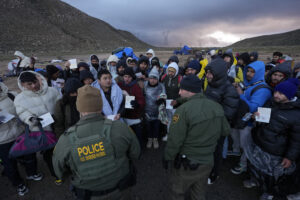Border Patrol Is Being Endowed With Frightening Powers
The Trump administration is creating a center to provide agents with access to classified info. Experts warn this is very dangerous. Mesa0789 / Flickr
Mesa0789 / Flickr
ProPublica is a nonprofit newsroom that investigates abuses of power. Sign up for ProPublica’s Big Story newsletter to receive stories like this one in your inbox as soon as they are published.
Pushing further toward its goal of “extreme vetting,” the Trump administration is creating a new center in suburban Virginia that will allow immigration agents to access, for the first time, the sprawling array of information scooped up by America’s intelligence agencies, from phone calls intercepted by the National Security Agency to material gathered by the CIA’s spies overseas to tips from informants in Central America.
This classified, potentially derogatory, information will eventually be used to screen everyone seeking to enter the United States, including foreign vacationers seeking travel visas, people applying for permanent residency or immigrants requesting asylum at the Mexican border.
Legal experts worry that immigration agents could potentially use this secret data to flag entire categories of people that fit “suspect” profiles and potentially bar them from entering the U.S., or prompt them to be tracked while they’re here. It could also be nearly impossible for those denied entry to challenge faulty information if wrongly accused, they say, since most of it is classified.
In an interview, the director of the new National Vetting Center, which is being overseen by U.S. Customs and Border Protection, was vague about the types of classified information that may be shared with immigration agencies but said the vetting center’s privacy and legal experts will make sure it conforms with the law.
“Right now, we’re still trying to get off the ground and are still focused on counterterrorism information which has already been used for vetting in the past,” said Monte Hawkins, a former National Security Council staffer who now works for CBP. “But as we fold in new types of derogatory information, yes, there’s potentially places where that type of information was never available before to make decisions.”
Hawkins, who helped write President Donald Trump’s February 2018 national security memo calling for the center’s creation, said that’s when the center’s lawyers will step in to “make sure” agents with agencies like U.S. Immigration and Customs Enforcement and CBP “are allowed to use that information or have the proper authority to do so.”
Spokespeople for the CIA, NSA and the Office of the Director of National Intelligence all declined to comment and referred questions back to the Department of Homeland Security, CBP’s parent agency, which did not respond to a request for comment.
The creation of the vetting center, particularly under the control of CBP and DHS, has alarmed civil rights and privacy experts as well as some who work in national security. They worry that CBP and ICE will use classified information to justify the surveillance of whole populations. And they worry that the center, once fully up and running, could allow the agencies to create their own de facto immigration policies through selective enforcement.
Rachel Levinson-Waldman, senior counsel for the Brennan Center’s Liberty and National Security Program, said the mere fact that the directive to build the center came from the same memo that called for the “Muslim travel ban” is cause for concern. “I think there’s a real worry about this new center expanding and growing,” she said. “Especially since it’s been created with the same discriminatory animus that’s behind extreme vetting and the Muslim ban. It’s not hard to see where this might end up.”
Levinson-Waldman and others also questioned putting classified intelligence information under the control of an agency like CBP, which has been criticized for a host of troubling behavior, including the targeting of activists, lawyers and journalists, and DHS, which has had three secretaries in three years and is currently waiting for Trump to appoint a fourth.
“You have an acting secretary who could be gone in an hour by tweet,” said Carrie Cordero, a senior fellow with the Washington-based bipartisan think tank Center for a New American Security. “The general counsel for DHS, who ultimately has the responsibility for making sure that oversight rules are followed, was just fired. So, there’s real questions as to what kind of management decisions are being made.”
Brian Katz, a former CIA analyst and now a fellow with the foreign policy think tank Center for Strategic and International Studies, said some members of the intelligence community are wary of DHS overseeing such a program because the agency is largely run by political appointees, who can be influenced by whatever agenda is being pushed by the president. “I think that’s particularly acute in this administration given the policies that DHS leadership has either been advocating or executing,” he said.
Both DHS and CBP, as well as ICE, have been scrutinized by a number of media outlets for their increasing reliance on algorithm-driven analytics and big data mining for immigration enforcement.
In August, ProPublica wrote about a 36-year-old Salvadoran man seeking asylum who was separated from his two children and thrown in jail for six months based on faulty gang intelligence provided by a State Department-funded fusion center called the Grupo Conjunto de Inteligencia Fronteriza, or GCIF. The center, which gathers information provided by police and the military in several countries, including El Salvador, shared the intelligence with CBP agents who were vetting asylum seekers at the border. The man’s attorney only learned of the existence of the fusion center after several months of litigation. But the exact nature of the faulty evidence provided by GCIF — or where it came from — has never been revealed because the government maintains that it is classified.
The case is exceptional because a team of high-profile law firms volunteered to litigate the complicated asylum case, which forced the government to provide at least some answers.
In the future, the new vetting center also could be used by CBP to vet asylum-seekers at the border, disguising even further the source of any faulty information.
“They’ll have no idea where the information is coming from,” Levinson-Waldman said of individuals trying to appeal their cases. “And this new vetting center will be artificially invested with this patina of accuracy that it may or may not deserve.”
The drive by CBP and ICE to collect large amounts of data began under the Obama administration, but it has grown exponentially under the Trump administration, which has pushed aggressively for the continuous monitoring of immigrants. Budgets for each agency have increased by more than $2 billion since Trump took office, according to a new report by the international think tank Transnational Institute. A substantial portion of this funding is being used to carry out new extreme vetting initiatives, such as the National Vetting Center.
CBP and ICE already collect vast amounts of unclassified personal information through intelligence gathering, social media web scraping, the collection of biographic and biometric data, and by purchasing access to local government or corporate databases that include information such as license plate numbers or whether someone receives food stamps.
All of this data is analyzed by computer programs that search for “contextual information” to help analysts build a profile on whomever they are investigating. A number of recent media reports have illustrated in detail how ICE and CBP have tracked and targeted immigrants for deportation using these methods.
Chinmayi Sharma, a former software developer who worked on government contracts and is now a lawyer specializing in technology and privacy, said what Trump is doing — through a series of presidential directives — is rapidly transforming immigration enforcement from a largely human interaction to computer analytics-based enforcement. Sharma wrote about the National Vetting Center and technology’s impact on enforcement for the national security blog Lawfare.
Ultimately, she said, the vetting center could usurp much of Congress’ oversight over immigration. Based on information from the center, immigration agents and consular officials could unilaterally grant or deny entry to the United States, perhaps excluding groups of people without having to account for their reasoning. “A lot of the president’s executive orders talk about ‘risky populations’ that aren’t even necessarily country related,” Sharma said. “Is it age group, is it religion, is it someone who identifies a certain way politically?”
“Someone who was legally in the country might not be allowed back into the United States now because they’re part of that risky population,” Sharma said. “All of a sudden something that used to be based on an individual assessment is now a population-based assessment.”
In an interview, Hawkins said the ways in which agents with CBP, ICE and other agencies ultimately use the vetting center is speculative at this point, since it’s currently only working on one program with CBP. But he said the agencies have legal guidelines they have to abide by before they can deny someone admission. “We’re giving them more information that might help them meet that bar, but there’s still a legal bar that has to be met.”
Also unclear is whether the nation’s intelligence agencies will welcome CBP to their community. Congress has previously said CBP and ICE are domestic law enforcement, not spy agencies. But Trump’s memo requires even the most sensitive intelligence agencies, including the NSA and the CIA, to share classified intelligence with the CBP-run center. It also requires the center to expand vetting beyond counterterrorism into new areas such as transnational crime and counterintelligence.
Some security experts like Katz, the former CIA analyst, are skeptical that it will succeed. “Obviously, this is an ambitious project on paper,” he said. “But counterintelligence is some of the most sensitive information the U.S. government collects, and there’s going to be reluctance to share that information.”
Katz wonders whether the vetting center is being created to solve a problem or merely to fulfill political ambitions. “If this is truly an intelligence or law enforcement-driven operation, then that bodes well for the idea of actually achieving its mission,” he said. “But if it’s not, and it’s just being built to sort of cherry-pick intelligence to achieve certain political goals, then this project will be ineffective and likely doomed to fail.”
Hawkins said that the intelligence community has been supportive, but that he couldn’t discuss the scope of their participation, since much of what the center does is classified.
“We’re not getting pushback in terms of the concept, really,” Hawkins said of the intelligence community. Most of the conversations have been about funding because their resources are limited, Hawkins said.
Another concern, he said, is what vetting will look like once it expands beyond counterterrorism.
In the counterterrorism world, analysts identify terrorists and then prevent them from coming in, Hawkins said. “But in counterintelligence that’s probably not the answer. Maybe you allow them to come in and track them or whatever,” he said. “So, we have to define for folks what we mean by vetting, because it’s different from counterterrorism.”
For now, he said, the vetting center is focused on counterterrorism and assisting CBP’s National Targeting Center in vetting applicants in its Electronic System for Travel Authorization program. Travelers from countries that don’t need a visa, such as Germany and the United Kingdom, must apply to ESTA before coming to the United States. In June, CBP began asking these visitors to list all of their social media accounts for the last five years. At the moment, the requirement is optional. But for travelers from countries that require a visa, it is already mandatory.
A look at the ESTA program provides a glimpse of how the center could work in vetting migrants on the nation’s borders.
Hawkins said the center takes the information provided by ESTA applicants and sends it to intelligence agencies, which then return any derogatory information they find. “That might be an ESTA applicant’s phone number that matches a phone number in a cable that [the intelligence agency] wrote and here’s all this bad stuff around that phone number that we think might be the same person, for example,” Hawkins said. “And they give us that cable to look at. Or it might be a link to a [terrorist] watch listed record … and so they say, ‘OK, you know this person seems to be this person on the watch list, here’s the link to that.’”
The center doesn’t have its own analysts, nor does it collect its own intelligence. For the ESTA program, CBP analysts are on site to receive the information. Hawkins said the center is designed to vet large numbers of applicants on a daily basis, which requires some automation but not entirely, he said.
“What we target are entire populations, or entire programs. We’re going to be looking at every single applicant … we’re not looking at subsets. So that our customer, be it ICE, CBP or USCIS, comes to us to get that classified information in real time or near real time to support their operation.” But, he said, “there’s always people looking at it, so it isn’t based on computers deciding who is good to go.”
Still, as these categories of information and potential threats expand, so does the number of people under suspicion and surveillance. “We know that DHS has targeted domestic protests and people providing legal services at the border,” Levinson-Waldman said. “As the scope of the National Vetting Center expands, it will be interesting to see whether it has a hand in the targeting that we know DHS is doing.”
Hawkins acknowledged that as the center takes on more vetting programs, privacy and civil liberties issues will need to be reviewed, especially if the center is allowed to add counterintelligence to its vetting pipeline by next summer. But, he said, before each new program is rolled out, the center’s lawyers will examine the program’s legality and release a privacy impact statement to the public.
Patrick Toomey, a senior staff attorney with the ACLU’s National Security Project, said that because everything is assessed by the center’s own attorneys, there’s no way to truly evaluate the impact it will have on the privacy of U.S. citizens and noncitizens.
“It really raises a lot of questions, because there’s so few specifics,” Toomey said. “What type of classified information is being shared for instance? None of that is explained.”
Hawkins acknowledged another conundrum at the heart of the new center: In the future, he said, if asylum-seekers, migrants or even visitors to the U.S. want to challenge decisions based on allegedly faulty intelligence provided through the center, they’ll have to appeal to the original agency where the information came from. Trouble is, the name of the agency providing the intelligence will likely be classified.
The National Vetting Center doesn’t have a redress system in place, he said. “We want to plug into whatever exists at these agencies. But we aren’t creating our own.”
None of this is reassuring to privacy and civil rights experts or to immigration attorneys and advocates.
“Right now, it’s a black box,” Levinson-Waldman said of the new center. “It’s hard not to be skeptical. Because there are plenty of examples from the past on how this could go wrong.”
Your support is crucial...As we navigate an uncertain 2025, with a new administration questioning press freedoms, the risks are clear: our ability to report freely is under threat.
Your tax-deductible donation enables us to dig deeper, delivering fearless investigative reporting and analysis that exposes the reality beneath the headlines — without compromise.
Now is the time to take action. Stand with our courageous journalists. Donate today to protect a free press, uphold democracy and uncover the stories that need to be told.






You need to be a supporter to comment.
There are currently no responses to this article.
Be the first to respond.